Rome Disappeared
Go to : ANCIENT ROME | MEDIEVAL ROME | RENAISSANCE ROME | BAROQUE ROME | ROMANTIC ROME | MODERN ROMEANCIENT ROME
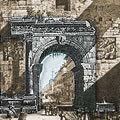
Arch of Portugal
The original name of this arch isn't known; it is known that it was located along Via Lata and was called Arcus Trofoli or de Tripolis with reference to a triumph concerning the victory over three cities but it isn't known which were and obtained by whom; it may have been erected under Marcus Aurelius, a hypothesis supported by spolium reliefs with representations of the Antonini dynasty ...
Continue »
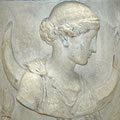
Temple of Moon Goddess
Luna was an archaic goddess of the Latins and her cult was brought to Rome by Titus Tatius but Servius Tullius was who built a temple to the goddess in a position overlooking the Porta Trigemina on the Aventine, the hill that had enclosed within its walls but left out of the Pomerius ...
Continue »
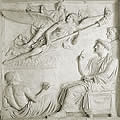
Ustrinum Hadriani
In the winter of 1867 Lanciani thought he had found the two temples of Dis and Proserpina instead he had found the Ustrinum of Hadrian, the sacred area where the emperor's body had been cremated.
In Tabula X of the Laws of the Twelve Tables of 490 BC it was written:Do not bury or cremate any dead inside the city
. The law required that the tombs be placed outside the sacred enclosure of theUrbs, the Pomoeriium, but the methods of body preservation were free; in the aarchaic age both the inhumation and the cremation were used but, already starting from the first century. B.C. ,the use of cremation in the second century it became a general practice so much that burial was almost the exception. Then ustrina were established, these were sacred areas where the pyres were raised for the bodies cremation ...
Continue »
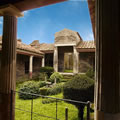
Domus Carinae, rostrums home of Pompeius Magnus
On the Fagutal slope right in front of the Velia hill, the gens Pompeia had built his domus and in the atrium, near the images of the ancestors, Pompeius Magnus had the rostra of ships that he had captured when he commanded the whole Roman fleet both in the campaign against the pirates of Cilicia, which eradicated in three months, both in the subsequent war against Mithridates VI king of Pontus ...
Continue »

Temple of Janus
Nothing remains of the Temple of Janus of which we only have a representation on the back of a Nero coin. It was located not far from the Forum ...
Continue »
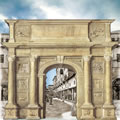
Arcus Novus
Along the Via Lata until the XV century there was a commemorative arch it was called Arcus Maior but in ancient Rome it was called Arcus Novus to ...
Continue »
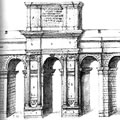
Arch of Claudius
When Claudius became emperor decided that for the glory of Rome would have done as much as his father Drusus and expanded the empire's territories ...
Continue »
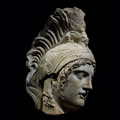
Templum Martis in Clivo
The oldest temple dedicated to the god of war, Mars, was located just outside the walls, past Porta Capena near the first miliarum the Via Appia, in a ...
Continue »
MEDIEVAL ROME
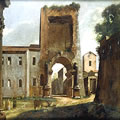
Turris Chartularia
In the Middle Ages, during the struggles for power, the noble families of Rome had built fortresses by choosing sites at the top and using the existing buildings as much as possible. The Frangipane family, perhaps a branch of the gens Anicia, was one of the most powerful in Rome and its surname derived from an ancestor, merchant by profession, who during a famine in the eighth century turned Rome distributing bread (fragnere panem = breaking bread ) to people suffering from hunger. In the twelfth century the famiy was divided into three branches, one of which had settled in Trastevere, another controlled the area of the Circus Maximus and the south-east of the Palatine where had fortified the Septizonium and had added a tower that still can be seen in the short side of the Circus Maximus, and called in the Middle Ages Turris in Capite Circi (but better known as Torre della Moletta for the small mill that stood next to it when the Fosso di S. Giovanni
still flowed in the valley); finally another settled in the saddle between Palatine and Velia and surrounded the whole Roman Forum with walls, incorporating the Arch of Titus which became a gate but on which it was also built in elevation to have a tower ...
Continue »
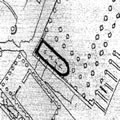
Medieval church over Basilica Julia
In the IX century A.D. on the left nave of the Basilica Julia - which already had been built warehouses for storage of hemp ...
Continue »
RENAISSANCE ROME

Via Alexandrina
Via Alexandrina was ordered by Pope Alexander VI who made enlarge the ancient Via Recta for the Jubilee in the year 1500; the road ran parallel with ...
Continue »
BAROQUE ROME
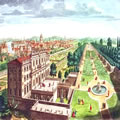
Villa Ludovisi Gardens
In the XVII century the Roman noble families and high cardinals loved to enjoy the warm weather outside the buildings, in urban villas where life flowed ...
Continue »
ROMANTIC ROME
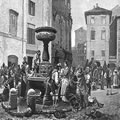
Piazza Montanara
At the end of the nineteenth century the Rome Capital of the Italy Kingdom of changed its face. To make a new image in Rome some quarters were completely distorted: houses, churches and roads cleared, thousands of people deported
outside the walls to give the city new monuments and try to recover the beauties of Ancient Rome. To allow the vision of mythical Rupe Tarpea it was decided to release the Capitoline Hill of the houses along Via della Bufala, via di Monte Caprino and Via della Consolazione and of the whole popular district that occupied the entire area up to the Theatre Marcellus ...
Continue »
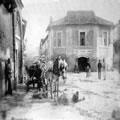
Tavern of the Saline
Yet in the nineteenth century salt to Rome he came from the salt marshes of Ostia pond in sacks after they were transported by boats that sailed up the Tiber to Ripa Marmorata. Here the sacks were then loaded onto wagons and carried to the Salt warehouses that were on the slopes of the nearby Aventine ...
Continue »
MODERN ROME
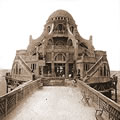
The Rotunda by the sea of Ostia
At the end of the eighteenth century in Brighton, the favorite holiday resort of the English nobility, a therapeutic center was built which, to exploit the benefits of the marine environment, had the particularity of being built in the water with a long walkway that connected it to the mainland. This type of establishment soon spread throughout Europe. The first example of Rotunda in Italy can be considered the one designed in 1782 by Vanvitelli, a stilt house in Monte di Procida on Lake of Fusaro ...
Continue »
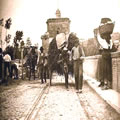
Tram in Rome: Milvian Bridge and Firedogs Bridge
The first tram in Rome passed on Milvian Bridge: among the many things he endured Milvian Bridge there was also the passage of the tram, although ...
Continue »






